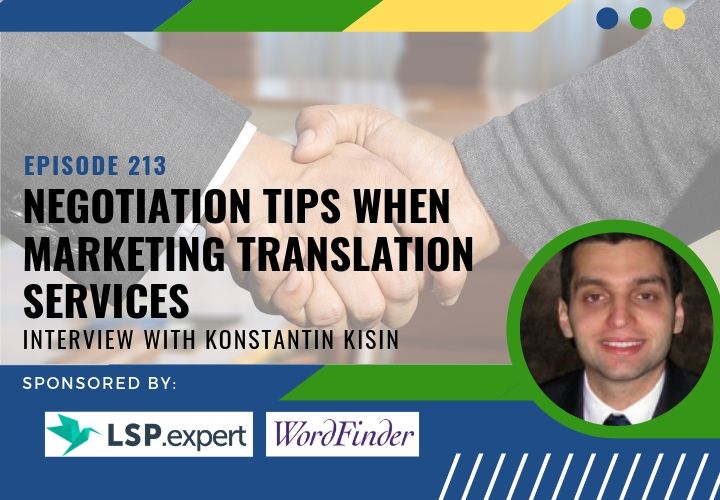
Episode 212: How to Position Yourself as an Expert to Translation Clients – Interview with Marta Stelmaszek
07/22/2019
Episode 213: Negotiation Tips When Marketing Translation Services – Interview with Konstantin Kisin
08/05/2019Since we freelance translators live all over the world, we can get away with charging a wide variety of rates. A translator in India charging the same price as someone in Australia, where the minimum wage is $16.88, would have a tough time getting business. That’s why it’s so important to come up with a base rate that’s good for both you and your client.
Unfortunately, it’s not as easy as punching a few numbers into a calculator.
The Factors Affecting Freelance Translation Rates
There’s no one-size fit all rate when it comes to translation. You wouldn’t want to charge a grandmother asking for a Christmas card the same price as a multi-million-dollar company. Below are a few things you need to consider before setting your rates:
- Your Language Pair: Some languages are easier to find translators for than others. Freelancers who speak and write in those rarer languages can charge a premium for their services. The rarity of a language pair is wholly dependent on where you live, however. A German to English translator is probably a lot easier to find in Germany than in Botswana.
- The Nicheness of Your Subject: It’s a lot easier to find a general translator than one certified to work in medical device manufacturing. The harder it is to find a freelance translator in your field, the more you can justifiably charge.
- The Client’s Document Layout: Most documents nowadays come in digital formats, but there are exceptions. Birth certificates and old medical documents are two things usually delivered as hard copies. Since paper is a lot harder to work with, you should charge a premium for it.
- The Client’s Deadline: Does your client need the translation done ASAP? If so, you’ll need to paid your rates accordingly. Treat it like any fulltime job and charge an extra 50-percent for rush, weekend, and overtime work. You’ll be amazed at how many clients find their project suddenly less pressing.
- The Type of Client: Are you working for a direct client or an agency? Direct clients should be charged 30-percent more than agency clients. Considering the agency would charge them 50 to 100-percent of your wages, this is still a deal for most clients.
- Certification: To translate official documents, you’ve got to be certified. Certification isn’t free. Your costs need to reflect the cost of your education and continued association fees. Otherwise, you’ll be stuck paying them out of pocket.
How to Calculate Your Translation Rates
Though your price may swing up or down depending on the items above, it’s important to set a base rate. Otherwise, you’ll be starting from scratch with every proposal. Here’s how to calculate one:
- Determine Your Desired Annual Income: How much do you want to make? Are you just looking to translate part-time or do you want to be one of the freelance translators bringing home over $100,000 a year? Stumped? Below are two things you can do to help you determine your goal income:
- Find Out What Your Country’s Median Salary Is: Just enter ‘median salary + your country” in Google and write down the result.
- Find an Equivalent Profession: You can also find a profession you believe required similar training to you and use that to set your goal rate. I’d say start with something like CPA or stenographer.
- Calculate Your Add-On Percentage: Do you believe you deserve more than the median income in your country? Does your second master’s degree justify a higher wage? If so, you’ll need to add a percentage to that median salary figure to reflect your worth.
- Calculate Your Self-Employment Costs: As a freelancer, you have costs that others don’t. To ensure you don’t end up paying for these out of pocket, you’ll need to incorporate these items into freelance translator rates:
- Business registration fees
- Bookkeeping and accountant fees
- Marketing and advertising costs
- Professional, health, and accident insurance
- Hardware and software upgrades
- Continued training and professional development
You can use this sheet to calculate these numbers. You’ll be surprised how quickly it all adds up!
- Figure Out Your Yearly Translation Volume: How many words can you translate an hour? How many hours do you spend translating a day? Multiply those two an hour to get your daily volume. Then, take that amount and multiply it by the average number of working days in your country. This should give you a decent estimate of what you can translate in a year.
- Add Up the Numbers from Steps 1 and 2: Take your goal annual salary and add your business costs to it.
- Divide by Your Annual Translation Volume: Divide the number from Step 5 by your annual word capacity. This will give you a rate-per-word. To get your hourly rate, take the value in Step 5 and divide it by the number of hours worked by the average person in your country.
How Do You Know if The Price is Right?
|
Signs Your Price Is Just Right |
Signs Your Price Is Too High or Low |
|
|
Need Some Help
If you want more help calculating your freelance translation rates, I have created a worksheet for you. This worksheet will help you figure out your monthly income per hour, your costs and your target rate per word and hour. Click below to download this worksheet for free:
Do you want monthly free marketing and business checklists and never miss any episodes, posts or marketing tips? Then I encourage you to subscribe to my newsletter. I will not spam you. Sign up below!



